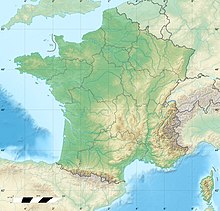Grotte du Vallonnet
| Grotte du Vallonnet | |
| Alternate name | Vallonnet cave |
|---|---|
| Location | near Roquebrune-Cap-Martin, between Monaco and Menton |
| Region | Alpes-Maritimes Department, France |
| Coordinates | 43°45′51″N 7°28′11″E / 43.76417°N 7.46972°ECoordinates: 43°45′51″N 7°28′11″E / 43.76417°N 7.46972°E |
| Site notes | |
| Excavation dates | 1962 |
Grotte du Vallonnet is an archaeological site located near Roquebrune-Cap-Martin, between Monaco and Menton, in France, that was first discovered in 1958. Stone tools found at the site have been dated to between 1 and 1,05 million years old, making it one of the earliest sites of human settlement known in Europe.
The cave of Vallonnet is located on the western slope of Cap Martin, about 800 m (2,600 ft) above the Bay of Menton, at Roquebrune-Cap-Martin in the Alpes-Maritimes Department in France. It opens onto a ravine with a small creek, the Vallonnet, which drops down to the Bay. The mountain is a massif of calcite-dolomitic rock formed during the Jurassic period, covered with puddingstone and hardened sands of the Miocene. The porch of the cave is narrow and low, and opens to a corridor 5 m (16 ft) in length, followed by a 4 m (13 ft) high room.
The cave was discovered in 1958 by 13 year old Marianne Poire, who had regularly visited the cave and collect pieces of calcite and one day showed them to René Pascal, an employee of a Monte Carlo casino and an amateur prehistorian. Marianne then lead her parents, Pascal and others to the entry of the cave. The first systematic excavations were carried out in 1962.
The excavations found five distinct layers of sediment in the cave:
Layer III contained the most important findings in the cave; a collection of animal bones, and 11 simple tools used by human visitors. It appears that the cave was used as a dining room by large carnivores, notably the bear, the panther, the saber-tooth tiger, and the large hyena. These brought to the cave the carcasses of herbivores; deer, bison, small bovides, rhinoceros, horses, and boars. When the predators were not in the cave, it was used by humans, who left the tools.
...
Wikipedia


